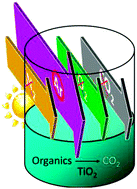Extraordinary effects of an argon atmosphere on TiO2 photocatalysis
Abstract
When used as a photocatalyst under solar light, TiO2 tends to show a low photocatalytic activity. We report here that even TiO2 exhibits a high photocatalytic activity toward the decomposition (mineralization) of aqueous organic contaminants under simulated solar light when used under an Ar atmosphere (Ar flow). The photocatalytic decomposition rate of a cationic dye, crystal violet, and the CO2 evolution rate over TiO2 (P25, mainly composed of anatase and rutile) under Ar flow were substantially higher than those obtained in air and under air, O2, N2 and CO2 flows. Similar positive effects of Ar flow on photocatalytic reactions were observed when another cationic dye, basic violet 4, and TiO2 (anatase) were used, suggesting the versatility of Ar flow for improving photocatalytic activities.


 Please wait while we load your content...
Please wait while we load your content...